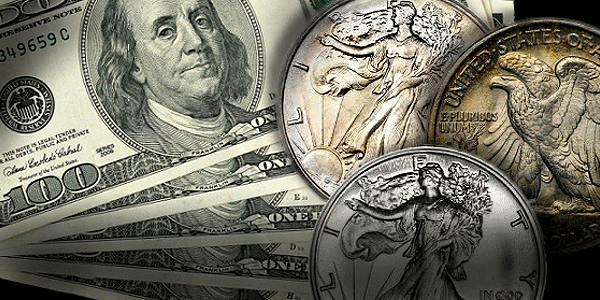
By Ron Drzewucki – www.moderncoinwholesale.com …..
The Walking Liberty short set is getting hot right now, and I for one couldn’t be happier.
Adolph Weinman’s Walking Liberty half dollar is one of the most beautiful coins ever produced in the United States, and Collectors have long respected it as one of the great American coins.
It’s also solidly modern, having ran from 1916 to 1947. It is the bridge between the Victorian Barber half dollar and the post-war Franklin half. It circulated alongside coin designs still extant today (such as the Lincoln cent, the Jefferson nickel and the Washington quarter), and classics like the Standing Liberty quarter and Saint-Gaudens’ gorgeous $20 gold double eagle.
And for the investors and silverites out there, it’s 90% silver.
Add to that the fact that the entire series tended to be weakly struck, and you have a coin that’s not only worthy of veneration but a fun challenge to all levels of collector.
If you’ve never heard of the short set, or even if you’re not terribly familiar with the coin itself, let me tell you a little bit about it–what it is, and why it’s so collectible.
I think you’re in for a treat.
The History
In 1915, the United States Mint was getting ready to change the designs on the dime, quarter, and half dollar. It was almost 25 years since Charles Barber had designed them, and, according to a law enacted in 1890, 25 years was the minimum amount of time that had to pass before American coinage could be changed. Apparently there was also some confusion about what exactly the law mandated, because the Mint’s new director, Robert Woolley, interpreted it to mean that he was required to produce new designs.
At any rate, the Barber coinage wasn’t much appreciated at the time and besides, it all kind of looked the same. After Teddy Roosevelt and Augustus Saint-Gaudens, some in government were impatient to complete the set, so to speak, and beautify the last remaining denominations.
So even if it was a peculiar (and wrong) interpretation of the law, people were ready for a change.
The Commission of Fine Arts (CFA)–the agency that guides the design and aesthetics of federal buildings in Washington, D.C.–selected Weinman’s designs for the Walking Liberty half dollar and the Mercury dime, alongside Hermon Atkins MacNeil’s Standing Liberty quarter.
The Design
Adolph Weinman was a German immigrant and student of the great Augustus Saint-Gaudens. But he didn’t just draw from his teacher (check out that sun). Weinman was also greatly inspired by the work of master sculptor Oscar Roty, whose famous “Sower” design on French coinage very much resembles Lady Liberty on Weinman’s half dollar. The flowing linens and dynamic pose catch one’s eyes right away, though it may be argued that Weinman improved on Roty’s placement on the coin, because while the perspective lines of the Sower give that design a greater depth of field, Weinman’s design makes better use of the coin’s canvas.
His Liberty is also not quite “sowing”. She holds branches and foliage in her left arm and has what could only be a really heavy American flag draped around her shoulders. Not quite the practical peasant of French coinage, but quite in tune with the allegorical approach preferred in the United States.
The reverse is just as dramatic, if not more so.
Eagles on federal coinage had come a long way since the goose-necked birds of 1794. One wonders if the early engravers knew what an eagle was.
But this… this was an eagle!
Weinman’s half dollar reverse features a bald eagle about to launch from its perch, its wings in mid-lift and its body thrust towards the sky. The solid body parts of the eagle convey a natural strength, and the whole composition is a miracle of aesthetic balance, all within an area of about 1.13 square inches–a genuine masterpiece!
The Strike
Unfortunately, the high relief of the coin–and, frankly, an overemphasis on aesthetics at the expense of the practicalities of the minting process–resulted in a tendency for weak strikes throughout the entire series. Charles Barber, while much of his attitude towards making the new designs work may have stemmed from sour grapes, was right to be concerned about the relief. He attempted several modifications, such as shrinking the art down and adding more space between Liberty’s head and the edge of the coin.
But in the end, nothing helped produce a stronger strike.
It was the coin equivalent of a Frank Lloyd Wright building with a leaky roof.
But boy, what an opportunity!
The Short Set
When Whitman Publishing put out coin folders for the series, they split it in two.
The first folder covered the years 1916 through 1940. The second folder finished it out, running from 1941 to 1947.
The series has its share of coins that the beginning collector may not necessarily be able to reasonably acquire. Interestingly, however, the hardest-to-find coins in the series all go in the first folder. This means that someone relatively new to coin collecting can complete the second folder. It’s proven to be such a useful way to collect that tradition has made the 1941-47 grouping of Walking Liberties a legitimate set–the “short” set.
But just because the coins of the short set are easier to find than some of the coins in the first folder doesn’t mean they’re not worthwhile. Remember, most Walking Liberty examples aren’t struck very well, so a strong or full strike is going to be worth much more than a typical specimen.
And it almost goes without saying that so would a gem or uncirculated example.
-Ron





Absolutely right. The 41s took me over 8 months to find just an ok strike in ms66.
They are majesticly conceived coins that deserve attention and adulation. When you find that perfect example that you have been searching for…… well, it’s a real simple pleasure of numismatic experience that every collector can and will appreciate.